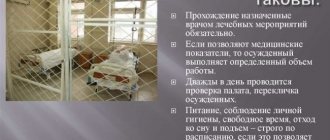ST 321 of the Criminal Code of the Russian Federation.
1. The use of violence that is not dangerous to the life or health of the convicted person, or the threat of violence against him in order to prevent the correction of the convicted person or out of revenge for the assistance he provided to the administration of an institution or body of the penal system - is punishable by imprisonment for a term of up to five years.
2. The acts provided for in the first part of this article, committed against an employee of a place of deprivation of liberty or a place of detention in connection with his official activities or his relatives, are punishable by imprisonment for a term of up to five years.
3. Acts provided for in parts one and two of this article, committed by an organized group or with the use of violence dangerous to life or health, are punishable by imprisonment for a term of five to twelve years.
Commentary to Art. 321 Criminal Code
1. Disorganization affects the activities of those special institutions that ensure the isolation of persons from society when executing their imprisonment-related penalties, as well as procedural coercive measures.
2. The victims include: a) those sentenced to punishments associated with isolation from society (parts 1 and 3); b) employees (persons with a special rank) of places of deprivation of liberty or places of detention or their relatives (parts 2 and 3). The named employees and their relatives may be victims when an attack on an employee is committed in connection with the performance of his official activities.
3. The objective side of the main elements (parts 1 and 2) is characterized either by the use of violence that is not dangerous to the life or health of the victim (see commentary to Article 318 of the Criminal Code), or by the threat of violence (intimidation by the use of physical violence of any intensity in the form , accessible to the victim’s perception of the expressed intimidation and clearly perceived by him).
The crime is considered completed from the moment one of these actions is committed.
4. The use of violence dangerous to life or health constitutes an act in the objective aspect of a qualified crime and is characterized either by the method - a danger to these benefits, or by the consequences - causing harm to health.
The content of the second qualifying feature—the commission of a crime by an organized group—is identical to the content of a similar feature in other crimes.
5. Subjective side - direct intent, as well as (according to the characteristics of the victim) either the goal of preventing the correction of the convicted person (parts 1 and 3) or the official activities of the employee (parts 2 and 3), or the motive of revenge on the convicted person for the assistance he provided to the administration of the institution or body of the penal system (parts 1 and 3) or an employee and his relatives in connection with the performance of official activities (parts 2 and 3).
6. Subjects are persons serving a sentence of imprisonment or being held in custody. Recognition of other persons as subjects is controversial.
Commentary on Article 321 of the Criminal Code of the Russian Federation
1. The social danger of a crime lies in the fact that it encroaches on the normal activities of an institution that ensures isolation from society, or a body of the penal system, as well as on the identity of the employees of these institutions, convicts and their relatives.
The victim of a crime provided for in Part 1 of the commented article can be a convicted person, i.e. a person against whom a guilty verdict has been passed and it has entered into force. Similar crimes against other persons in places of detention (suspects, accused) do not fall under the scope of the commented article.
2. From the objective side, the crime consists of disorganizing the activities of institutions that ensure isolation from society, through the use of violence that is not dangerous to life or health, or the threat of violence against convicts (see commentary to Article 318). The threat must be real. No consequences from the threat are required.
The crime is considered completed from the moment the specified violence is used or threats are made in various ways, regardless of whether it was used to disrupt the activities of institutions that ensure isolation from society.
Institutions that provide isolation from society are, for example, correctional colonies, educational colonies, prisons, pre-trial detention centers.
3. The crime is committed with direct intent. The person is aware of the public danger of using violence that is not dangerous to the life or health of the convicted person, or the threat of using such violence, is aware that he is using it against the convicted person, and desires this. A mandatory feature of the subjective side is the goal of preventing the convict from reforming or the motive of revenge for the assistance he provided to the administration of an institution or body of the penal system.
4. The subject of the crime is special - convicted, sane, over 16 years of age. Persons aged 14 to 16 years are prosecuted for such acts under articles of the Criminal Code on crimes against the person.
5. Part 2 of the commented article provides for an independent corpus delicti. It is formed by the acts specified in Part 1 of this article, committed against an employee of a place of deprivation of liberty or a place of detention or his relatives.
The law names two categories of victims of this crime. Firstly, these are employees of places of deprivation of liberty or places of detention. The place of deprivation of liberty is correctional colonies, prisons, educational colonies, settlement colonies (Article 74 of the Penal Code). Place of detention - pre-trial detention centers of the penal system, temporary detention centers for suspects and accused of internal affairs bodies; temporary detention centers for suspects and accused border agencies of the federal security service; institutions of the penal system that carry out criminal punishment in the form of imprisonment, and guardhouses (Article 7 of the Federal Law of July 15, 1995 N 103-FZ “On the detention of suspects and accused of committing crimes” (as amended on December 3, 2011 ) <1>).
——————————— <1> NW RF. 1995. N 29. Art. 2759; 1998. N 30. Art. 3613; 2001. N 11. Art. 1002; 2003. N 1. Art. 2; N 27 (part 1). Art. 2700; N 50. Art. 4847; 2004. N 27. Art. 2711; N 35. Art. 3607; 2005. N 10. Art. 763; 2006. N 17 (part 1). Art. 1779; 2007. N 7. Art. 830, 831; N 30; Art. 3808; N 31. Art. 4011; N 45. Art. 5418; 2009. N 39. Art. 4538; 2010. N 27. Art. 3416; 2011. N 1. Art. 46; N 7. Art. 901; N 15. Art. 2022; N 17. Art. 2319; N 49 (part 5). Art. 7056.
An employee of a place of deprivation of liberty is a person who has a special rank of private or commanding officer. Their status is regulated in Art. 24 of the Law of the Russian Federation of July 21, 1993 N 5473-1 “On institutions and bodies executing criminal penalties in the form of imprisonment” (as amended on December 30, 2012) <1>. If a crime is committed in a place of deprivation of liberty against a government official who is not an employee of this institution (for example, a prosecutor), the act should be qualified under Art. 318 of the Criminal Code in the presence of all the signs of the crime provided for therein.
——————————— <1> Vedomosti RF. 1993. N 33. Art. 1316; NW RF. 1998. N 30. Art. 3613; 2004. N 27. Art. 2711; 2007. N 24. Art. 2834; 2009. N 39. Art. 4537; 2010. N 15. Art. 1742; N 27. Art. 3416; N 45. Art. 5745; 2011. N 7. Art. 901; N 45. Art. 6328; N 49 (part 5). Art. 7056; 2012. N 14. Art. 1551.
An employee of a place of detention is a person of ordinary or commanding staff of internal affairs bodies, an employee of institutions and bodies of the penal system, a military serviceman of the FSB of Russia and the Armed Forces of the Russian Federation, performing duties to ensure the regime of detention (Article 12 of the Federal Law “On detention of suspects and accused of committing crimes").
A crime is committed only in connection with the official functions of employees of relevant institutions, because only in this case can it disorganize the activities of institutions that ensure isolation from society.
Secondly, the victims of a crime may be relatives of the persons specified in Part 2 of the commented article (see commentary to Article 317).
Part 3 of the commented article establishes liability for the commission of acts provided for in parts 1 and 2 of this article: a) by an organized group (see commentary to Article 35) or b) with the use of violence dangerous to life or health (see commentary to Article 318).
Second commentary to Art. 321 of the Criminal Code of the Russian Federation
1. The activities of correctional institutions entrusted with the duty of executing sentences, as well as the activities of pre-trial detention centers are regulated by the legislation of the Russian Federation: the Law of the Russian Federation of July 21, 1993 “On institutions and bodies executing criminal punishment in the form of imprisonment” and the Federal Law of the Russian Federation dated July 15, 1995 “On the detention of suspects and accused of committing crimes.” In accordance with the legislation, as well as with paragraph 2 of the resolution of the Plenum of the Supreme Court of the USSR dated 06.21.1985 “On judicial practice in cases of criminal liability for actions that disrupt the work of correctional labor institutions”, to the administration of places of deprivation of liberty, as well as temporary detention centers include: persons in command; military personnel of the Internal Troops; persons who provide general education and vocational training, medical care, and management of the production activities of convicts in these institutions.
2. Employees of a place of deprivation of liberty or a place of detention, in addition to the administration of the institution, include employees who have special ranks of ordinary or commanding personnel of the internal affairs bodies of the Russian Federation; workers and employees of all institutions included in the penal system (including medical and correctional institutions).
3. Employees of places of detention include members of the rank-and-file and commanding staff of internal affairs bodies, employees of institutions and bodies of the FSB, the Border Troops of the Russian Federation and the Armed Forces of the Russian Federation, performing duties to ensure the regime of detention, captains of sea vessels and heads of winter quarters.
4. Persons close to employees of places of deprivation of liberty and places of detention are determined in accordance with the criteria formulated when considering the elements of the crime provided for in Art. 317 CC.
5. Disorganization of the activities of institutions that ensure isolation from society is provided for by two independent offenses provided for in parts 1 and 2 of the commented article.
The objective signs of the acts provided for in parts 1 and 2 of Article 321 of the Criminal Code are identical: the use of violence that is not dangerous to life and health, or the threat of violence (see: commentary on Article 318 of the Criminal Code). According to Part 1 of Art. 321 of the Criminal Code, these actions are carried out in relation to the convicted person, and under Part 2 - in relation to an employee of the place of deprivation of liberty or place of detention.
6. The subjective side of the crime provided for in Part 1 of Art. 321 of the Criminal Code, includes the direct intent and purpose of preventing the correction of a convicted person or the motive of revenge for the assistance he provided to the administration of an institution or body of the penal system.
7. The subjective side of the crime provided for in Part 2 of Art. 321 of the Criminal Code, includes the direct intent and purpose of obstructing the activities of an employee of a place of deprivation of liberty or a place of detention, or the motive of revenge for carrying out official activities.
8. The subject of the crimes provided for in parts 1 and 2 of Article 321 of the Criminal Code is a convicted person serving a sentence in a place of deprivation of liberty, a suspect or accused, held in a temporary detention center (pre-trial detention center), who has reached the age of 16.
9. A qualified type of disruption of the activities of institutions that ensure isolation from society is provided for in Part 3 of Art. 321 CC. Its content, in addition to the main elements, includes qualifying signs of committing a crime by an organized group or with the use of violence dangerous to life and health. For the content of these signs, see: comments to Articles 105 and 162 of the Criminal Code of the Russian Federation.
Judicial practice: sentences and punishment under Art. 321 of the Criminal Code of the Russian Federation
- Decision of the Supreme Court: Determination N 203-APU17-21... THE SUPREME COURT OF THE RUSSIAN FEDERATION Case No. 203-APU17-21 APPEAL DECISION Moscow August 31, 2022 Judicial Collegium for Military Personnel of the Supreme...
- Resolution of the Plenum of the Supreme Court of the Russian Federation dated... PLENARY OF THE SUPREME COURT OF THE RUSSIAN FEDERATION DECISION dated December 27, 2002 N 29 ON JUDICIAL PRACTICE IN CASES OF THEFT,...
- Resolution of the Plenum of the Supreme Court of the Russian Federation dated... PLENARY OF THE SUPREME COURT OF THE RUSSIAN FEDERATION DECISION of November 15, 2016 N 48 ON THE PRACTICE OF APPLICATION BY COURTS OF LEGISLATION GOVERNING FEATURES...
- Decision of the Supreme Court: Resolution No. 310P13 dated... DECISION OF THE PRESIDIUM OF THE SUPREME COURT OF THE RUSSIAN FEDERATION Case No. 310-P13 Moscow January 23, 2014 Presidium of the Supreme Court of the Russian Federation...
- Resolution of the Presidium of the Supreme Court of the Russian Federation dated... PRESIDIUM OF THE SUPREME COURT OF THE RUSSIAN FEDERATION DECISION dated December 5, 2018 N 126-P18 ON RESUMING PROCEEDINGS IN THE CASE DUE TO NEW...
- Judicial Collegium for Criminal Cases, appeal:... THE SUPREME COURT OF THE RUSSIAN FEDERATION Case No. 72-APU 17-21 APPEAL DECISION Moscow October 04, 2022 Judicial Collegium for Criminal Cases...
- Ruling of the ECtHR dated 02/14/2017 EUROPEAN COURT OF HUMAN RIGHTS THIRD SECTION CASE “MASLOVA VS. RUSSIAN FEDERATION” (Complaint No. 15980/12) JUDGMENT…
- Ruling of the Constitutional Court of the Russian Federation dated March 13, 2018 N 578-O THE CONSTITUTIONAL COURT OF THE RUSSIAN FEDERATION RULING dated March 13, 2018 N 578-O ON THE REFUSAL TO ACCEPT A CITIZEN’S COMPLAINT FOR CONSIDERATION...
- Decision of the Supreme Court: Determination No. 38-АПУ17-2 dated... THE SUPREME COURT OF THE RUSSIAN FEDERATION No. 38-АПУ17-2 APPEAL DECISION Moscow March 1, 2022 Judicial Collegium for Criminal Cases of the Supreme Court...
- Resolution of the Plenum of the Supreme Court of the Russian Federation dated... PLENAUM OF THE SUPREME COURT OF THE RUSSIAN FEDERATION DECISION dated December 17, 2022 N 43 ON SOME ISSUES OF JUDICIAL PRACTICE IN CASES...


